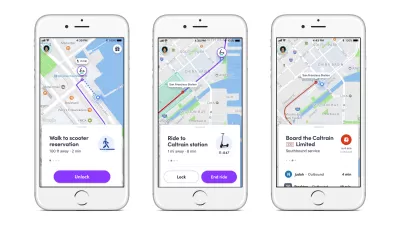Bridj's bet that it could, well, bridge ride-hailing and public transit didn't pay off. Lacking new investment, the company is shutting down.

Inspired by the success of Uber and Lyft, Bridj attempted to disrupt public transit with a van-based model. Linda Poon writes, "Bridj works by allowing users to request a ride in one of its 14-seat vans whose routes are calculated by an algorithm so that riders are picked up and dropped off in the most efficient manner. Each ride costs passengers between $1.50 and $7, depending on what’s agreed upon with the city."
The startup saw some early success by partnering with Ford. "It shortened trips for thousands of Boston commuters, it eventually extended limited service to Washington, D.C., and Austin, Texas, and it got Ford Motors Co. and the Kansas City Area Transit Authority to pilot a year-long experiment in Missouri."
Now, as the company shuts its doors, the question is why couldn't Bridj catch on. "Many didn't use the app beyond the first 10 free rides, despite the fact that the service attracted a largely younger and wealthier crowd—which raised the question of whether Bridj was accessible for the low-income population." Marketing was also lacking, and the company had trouble identifying where shuttles would be needed most.
FULL STORY: Bridj Collapses After Just 3 Years

Alabama: Trump Terminates Settlements for Black Communities Harmed By Raw Sewage
Trump deemed the landmark civil rights agreement “illegal DEI and environmental justice policy.”

Study: Maui’s Plan to Convert Vacation Rentals to Long-Term Housing Could Cause Nearly $1 Billion Economic Loss
The plan would reduce visitor accommodation by 25% resulting in 1,900 jobs lost.

Why Should We Subsidize Public Transportation?
Many public transit agencies face financial stress due to rising costs, declining fare revenue, and declining subsidies. Transit advocates must provide a strong business case for increasing public transit funding.

Paris Bike Boom Leads to Steep Drop in Air Pollution
The French city’s air quality has improved dramatically in the past 20 years, coinciding with a growth in cycling.

Why Housing Costs More to Build in California Than in Texas
Hard costs like labor and materials combined with ‘soft’ costs such as permitting make building in the San Francisco Bay Area almost three times as costly as in Texas cities.

San Diego County Sees a Rise in Urban Coyotes
San Diego County experiences a rise in urban coyotes, as sightings become prevalent throughout its urban neighbourhoods and surrounding areas.
Urban Design for Planners 1: Software Tools
This six-course series explores essential urban design concepts using open source software and equips planners with the tools they need to participate fully in the urban design process.
Planning for Universal Design
Learn the tools for implementing Universal Design in planning regulations.
Smith Gee Studio
Alamo Area Metropolitan Planning Organization
City of Santa Clarita
Institute for Housing and Urban Development Studies (IHS)
City of Grandview
Harvard GSD Executive Education
Toledo-Lucas County Plan Commissions
Salt Lake City
NYU Wagner Graduate School of Public Service





























